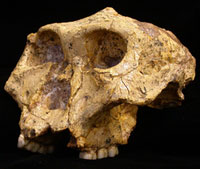Approx. 3 million years ago, females rather than males moved from the groups they were born in to new social groups.
So far ranging and residence patterns amongst early hominins have been indirectly inferred from morphology, stone tool sourcing, comparison to living primates and phylogenetic models. An international team of researchers including Sandi Copeland, Vaughan Grimes and Michael Richards of the Max Planck Institute for Evolutionary Anthropology in Leipzig/Germany have now investigated landscape use in Australopithecusafricanus (with fossils from sites dating between 2.8-2.0 million years ago) and Paranthropus robustus (with fossils from sites dating between 1.9-1.4 million years ago) from the Sterkfontein and Swartkrans cave sites in South Africa using strontium isotope analysis. This method helps identify the geological substrate on which an animal lived during tooth mineralization. (Nature, June 2nd, 2011)
